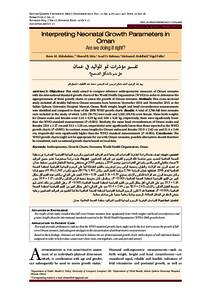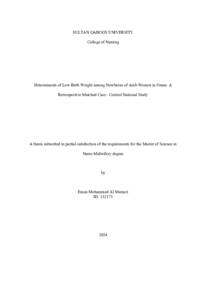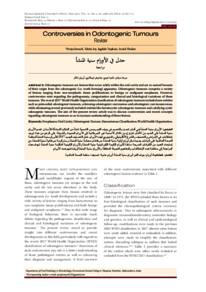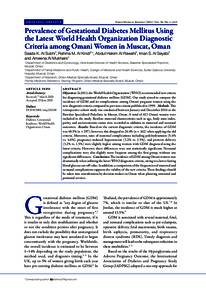Document
Interpreting neonatal growth parameters in Oman : are we doing it right?.
Identifier
doi: 10.18295/squmj.2017.17.04.006
Contributors
Idris, Ahmed B., Author
Ur-Rahman, Asad., Author
Abdellatif, Mohamed., Author
Fuller, Nigel., Author
Other titles
تفسير مؤشرات نمو المواليد في عمان هل يتم بالشكل الصحيح؟
Publisher
College of Medicine, Sultan Qaboos University.
Gregorian
2017-11
Language
English
English abstract
Objectives:This study aimed to compare reference anthropometric measures of Omani neonates
with the international standard growth charts of the World Health Organization (WHO) in order to determine the
appropriateness of these growth charts to assess the growth of Omani neonates. Methods: This cross-sectional
study included all healthy full-term Omani neonates born between November 2014 and November 2015 at the
Sultan Qaboos University Hospital, Muscat, Oman. Birth weight, length and head circumference measurements
were identified and compared to those of the 2006 WHO growth charts. Results: A total of 2,766 full-term neonates
were included in the study, of which 1,401 (50.7%) were male and 1,365 (49.3%) were female. Mean birth weights
for Omani males and females were 3.16 ± 0.39 kg and 3.06 ± 0.38 kg, respectively; these were significantly lower
than the WHO standard measurements (P <0.001). Similarly, the mean head circumferences of Omani males and
females (33.8 پ} 1.27 cm and 33.3 پ} 1.26 cm, respectively) were significantly lower than those reported in the WHO
growth charts (P <0.001). In contrast, mean lengths for Omani males and females (52.0 پ} 2.62 cm and 51.4 پ} 2.64
cm, respectively) were significantly higher than the WHO standard measurements (P <0.001). Conclusion: The
WHO growth charts might not be appropriate for use with Omani neonates; possible alternatives should therefore
be considered, such as national growth charts based on local data.
Member of
Resource URL
Arabic abstract
لهدفة تهدف هذه الدراسة لمقارنة القياسات المرجعية لنمو المواليد العمانيين بالرسوم البيانية القياسية الصادرة عن منظمة الصحة العالمية لتحديد مدى مناسبة تلك الرسوم لتقييم نمو المواليد العمانيين. الطريقة، هذه دراسة مستعرضة تضم جميع المواليد الأصحاء مكتملي النمو والذين ولدوا في الفترة ما بين نوفمبر 2014 و ونوفمبر 2015 في مستشفى جامعة السلطان قابوس، مسقط، عمان ثم تحديد الوزن عند الولادة، والطول، ومحيط الرأس ومن ثم قورنت بالقيم المقابلة لها على الرسوم البيانية القياسية لمنظمة الصحة العالمية لعام 2006. النتائج، شملت الدراسة 2,766 مولودا كامل النمو، وكان 1,401 (50.7%) منهم ذكورا و 1,365 (49.3%)منهم إناثا.
متوسط الوزن عند الولادة للذكور والإناث يساوي 3.16 ± 0.39 kg and 3.06 ± 0.38 kg على التوالي ، وكانت هذه القيم أقل بشكل كبير من القيم القياسية لمنظمة الصحة العالمية (P <0.001) . وبالمثل، كان متوسط محيط الرأس للذكور والإناث (1.27 33.8 ± سم و 33.3 ± 1.26 سم ، على التوالي) أقل بشكل كبير من القيم القياسية لمنظمة الصحة العالمية (P <0.001) وعلى العكس من ذلك، كانت قيم متوسط الطول للذكور والإناث (2.62 52.0 ± سم و 51.4 ± 2.64 سم ، على التوالي)
أعلى بشكل كبير من القيم القياسية لمنظمة الصحة العالمية (P <0.001) .
الخلاصة:قد لا تكون الرسوم البيانية القياسية لمنظمة الصحة العالمية ملائمة لتقييم نمو المواليد العمانيين، وعليه ينبغي النظر في البدائل الممكنة، كرسوم بيانية وطنية مبنية على بيانات محلية.
متوسط الوزن عند الولادة للذكور والإناث يساوي 3.16 ± 0.39 kg and 3.06 ± 0.38 kg على التوالي ، وكانت هذه القيم أقل بشكل كبير من القيم القياسية لمنظمة الصحة العالمية (P <0.001) . وبالمثل، كان متوسط محيط الرأس للذكور والإناث (1.27 33.8 ± سم و 33.3 ± 1.26 سم ، على التوالي) أقل بشكل كبير من القيم القياسية لمنظمة الصحة العالمية (P <0.001) وعلى العكس من ذلك، كانت قيم متوسط الطول للذكور والإناث (2.62 52.0 ± سم و 51.4 ± 2.64 سم ، على التوالي)
أعلى بشكل كبير من القيم القياسية لمنظمة الصحة العالمية (P <0.001) .
الخلاصة:قد لا تكون الرسوم البيانية القياسية لمنظمة الصحة العالمية ملائمة لتقييم نمو المواليد العمانيين، وعليه ينبغي النظر في البدائل الممكنة، كرسوم بيانية وطنية مبنية على بيانات محلية.
Category
Journal articles




